Physical Address
304 North Cardinal St.
Dorchester Center, MA 02124
10.1
10.2
10.3
10.4
10.5
10.6
10.7
10.8
10.9
10.10
10.11
10.12
Visit Expert Consult ( expertconsult.inkling.com ) for videos on topics discussed throughout the text.
When you see a patient with tearing, the goal is to determine the cause of the tearing problem and the appropriate treatment. A pathologic condition may occur anywhere along the path of tearing, from the production to drainage of tears. If you know the specific questions to ask during the history taking, you get a good idea of the cause of the tearing and the severity of the problem. I think of a watery eye as a different problem than a tearing eye. The watery eye can be caused by a number of problems that are usually not specifically related to obstruction of the lacrimal drainage system. The tearing eye is almost always the result of canalicular or nasolacrimal duct (NLD) obstruction. The patient’s age is a good clue to the probable cause of the problem. A tearing eye in a 70-year-old patient almost always has a different cause than a tearing eye in a child. There are three mechanisms that make an eye tear.
Overproduction
Reflex tearing
Poor lacrimal pump
Weak or loose eyelids
Inadequate drainage
Canalicular obstruction
NLD obstruction
After you have a good idea from the history of what the problem is, the physical examination either confirms your suspicion or points you to another diagnosis. If a cause of eye irritation or poor pumping of tears is not seen during the examination, the cause is lacrimal drainage obstruction. This is confirmed by the lacrimal system vital signs, which are determined by the dye disappearance test, palpation of the canaliculi, and irrigation of the NLD. When you know the site of obstruction, the treatment choice is clear.
There are many conditions affecting tearing that can cause the patient to seek your help. The examination can be long and unrewarding if your goal is unknown at the start. If you master the concepts in this chapter, the diagnosis of the majority of lacrimal drainage problems becomes easy. The treatments are successful in most patients.
Let us review briefly the anatomy of the lacrimal system. Think of the system in these functional terms:
Production
Distribution
Drainage
Three layers of tears are produced to form the tear film. The lacrimal gland produces aqueous tears ( Figure 10.1 ). The accessory lacrimal glands of Wolfring and Krause produce additional aqueous tears. The middle aqueous layer adheres to the eye with the help of an inner mucous layer from the conjunctival goblet cells. Evaporation of the aqueous layer is reduced by a layer of oil superficial to the aqueous film produced by the oil glands of the eyelid. As you already know, these glands are primarily the meibomian glands of the tarsus and the Zeis glands associated with the eyelashes at the eyelid margin. All the glands producing the tear film must be healthy to keep a healthy thick layer of tears on the eye. Any problem in one layer may upset the system. An example is the eye irritation caused by blepharitis. In theory, the aqueous and mucous layers are okay, but the oil layer is not.

How are the distribution and drainage of tears related? Normal eyelid function is required for both. Normal blinking spreads the tears across the eye. The same normal blinking pumps the tears into the sac and down the NLD, the so-called lacrimal pump. Any abnormality in the frequency or quality of the blinking affects the distribution of tears. You have seen examples of both reduced frequency and quality of blinking. Patients with Parkinsonism blink only occasionally, causing symptoms of eye irritation and watery eyes. Patients with facial nerve palsy have a poor-quality blink. By this, I mean that the blink is not complete; the inferior cornea does not get wet. Ocular irritation resulting from conjunctival and corneal exposure is the result. The irritation may cause reflex tearing resulting in a watery eye . With facial nerve palsy, the strength of the blink is also decreased, reducing the force of the lacrimal pump. If the lid is ectropic or the pump is very poor, a tearing eye may occur. Two causes of the watery eye are:
Reflex tearing
Poor lacrimal pump
Reread this section on anatomy and function. The concepts of poor-quality tear production, inadequate distribution of tears, and reduced lacrimal pump function are difficult to understand when you are learning to estimate their contribution to a patient’s problem. You are likely to see many patients that suffer from a watery eye. Anatomic blockage of the lacrimal system is easier to diagnose and easier to fix.
Normal tear drainage depends on a functioning lacrimal pump and an intact lacrimal drainage system ( Figure 10.2 ). As you recall from Chapter 2 , the tears enter the upper and lower puncta and travel in a short vertical portion of the puncta for 1 or 2 mm before entering the horizontal portion of the canaliculi. The canaliculi enter the lacrimal sac at an angle, which forms a sort of valve (common internal punctum). The lacrimal sac sits in the lacrimal sac fossa bounded by the anterior lacrimal crest (maxillary bone) and the posterior lacrimal crest (lacrimal bone). The sac narrows inferiorly, forming the NLD (membranous NLD). The duct passes inferiorly through a bony canal (osseous NLD) to open beneath the inferior turbinate into the inferior meatus of the nose. The valve of Hasner at this opening prevents retrograde flow of tears or air up into the duct from the nose. An abnormality anywhere along this path can delay or block the drainage of the tears, usually causing a tearing eye. Anatomic obstruction can occur in the canaliculi or the NLD.
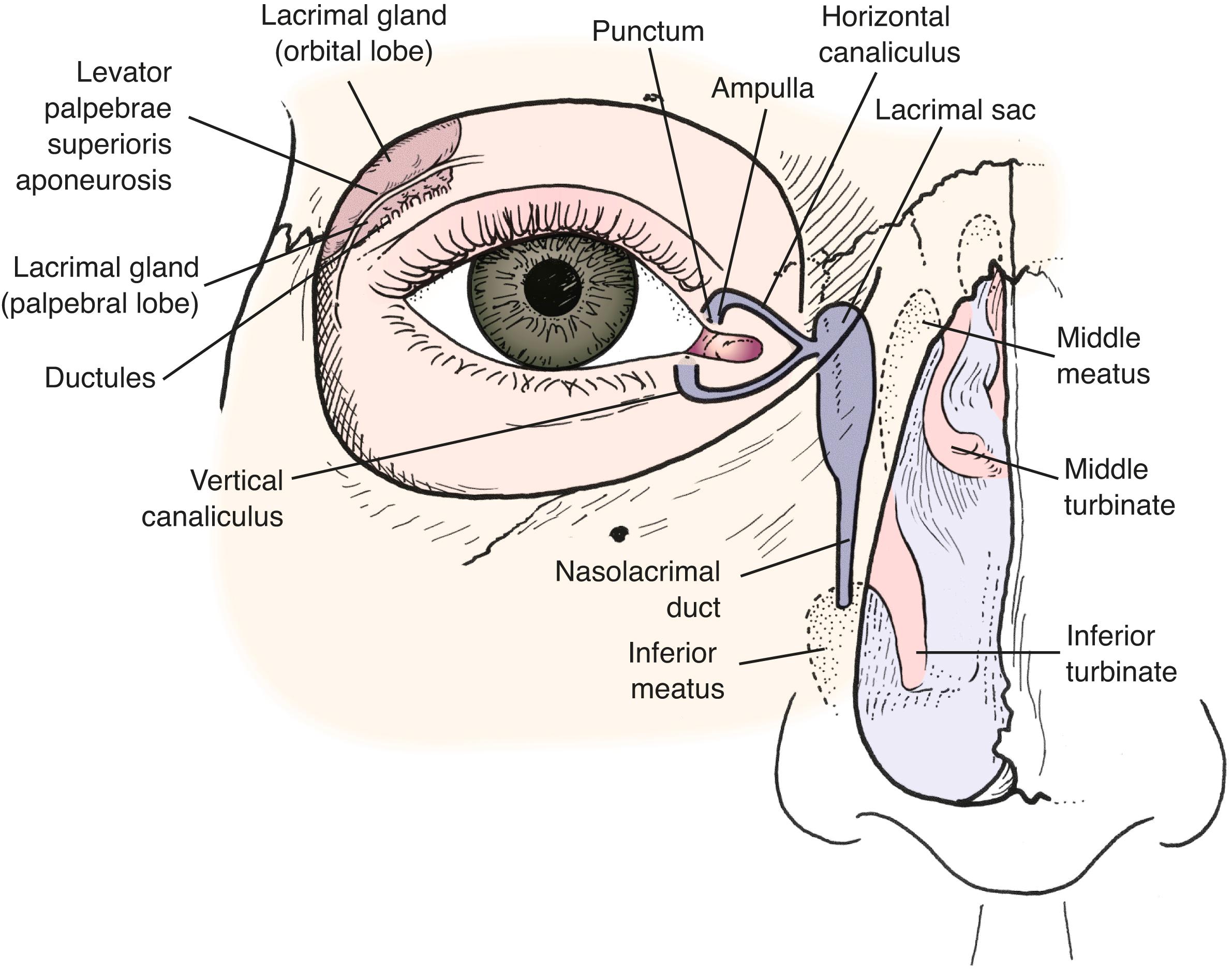
As alluded to above, one or more of three possible problems (simplified) exists:
Too many tears
Poor pumping of tears
Poor drainage of tears
Our job is to figure out which of the three problems exist.
As you have seen earlier, I try to divide the patient’s complaint into the watery eye or the tearing eye . The watery eye does not spill tears onto the cheek. The tearing eye has true epiphora, meaning that tears overflow onto the cheek. Make sure that you understand this difference. When your patient tells you the eye waters, ask “Do the tears flow down your cheek or do they stay in your eye?” It is surprising how many patients tell you that they have tearing but that no tears overflow.
What do the answers to these questions mean? The watery eye can be caused by a number of problems. Most of these problems are related to poor tear film, causing ocular irritation (or reflex tearing). There may be a subtle problem with one of the layers of the tears or the distribution of the tears, as we said above. These conditions improve with medical management, such as lid hygiene and use of artificial tears and lubricating ointments. Watery eyes caused by an abnormal lid position or a poorly functioning pump are usually easy to diagnose on physical examination.
The tearing eye (true epiphora) is usually caused by poor drainage of tears though the lacrimal system. There are exceptions to this, but in the absence of other obvious problems causing reflex tearing (e.g., an inflamed eye or trichiasis) or a lacrimal pump problem (ectropion or a facial nerve palsy), epiphora means obstruction, and an operation is required to eliminate the tearing. I repeat this concept because it is important: in the absence of a cause of reflex tearing or obvious lacrimal pump problem, epiphora means obstruction of the lacrimal drainage system. Read the above two paragraphs again! For me, the difference between a watery eye and a tearing eye (true epiphora) is a huge help toward making the correct diagnosis.
The presence of epiphora depends on how complete the obstruction is and how many tears are being made. If the tears flow down your patient’s cheek, ask, “Do the tears flow down your cheek when you are inside and resting or mainly when you are outside in the cold and wind?” Everyone’s system makes more tears in the wind or cold (this is a tear drainage stress test of sorts). If tearing is present only in the wind and cold, the obstruction is more likely partial or not complete. Remember that young patients’ systems make more tears than older patients’ systems, so tear overflow is seen more readily in younger patients than in older patients with the same anatomic problem. In fact, the lacrimal gland of many older adults makes so few tears that epiphora is not present despite a complete blockage of the lacrimal drainage. With NLD obstruction, these patients may exhibit signs of chronic dacryocystitis (mucopurulent drainage) or acute dacryocystitis (painful swelling of the medial canthus) but have no tearing. On the other hand, a young patient may have bothersome epiphora with only slight eversion of one punctum. An older patient with the same punctal eversion does not notice any epiphora.
Remind yourself of one or two problems that can affect tearing:
Production: too many tears
Distribution: poor pump
Drainage: blockage of NLD
Make a sketch of the normal anatomy of the lacrimal drainage system.
What is the clinical difference between a watery eye and a tearing eye (epiphora)?
What is implied by a diagnosis of true epiphora?
Remember the questions:
“Do the tears flow down your cheek or do they stay in your eye?”
“Do the tears flow down your cheek when you are inside and resting or mainly when you are outside in the cold and wind?”
Things are getting a bit complicated, so let us go back to the general rules. Epiphora (tears on the cheek) implies a blockage in the drainage system. Watery eyes suggest a tear film or subtle blinking problem.
We have already discussed the significance of epiphora. There are always exceptions, but in most patients, NLD obstruction occurs initially as a unilateral problem. A history of dacryocystitis means that an NLD obstruction is present. Onset after conjunctivitis suggests that the puncta or the canaliculi have become obstructed as a result of a viral infection (one of the few bilateral onsets). Onset after facial fracture or nasal surgery implies damage to the NLD ( Box 10.1 ).
True epiphora: tears on cheek
Unilateral symptoms
History of dacryocystitis
Acute infection
Mucoid discharge with pressure on sac
Onset after:
Conjunctivitis
Facial fracture
Nasal surgery (history of nasal surgery)
As we discussed in the earlier sections, a patient may complain of watery eyes. No true epiphora is present. The exact meaning of this complaint can vary from patient to patient. Watery eyes may mean ocular irritation, mucoid discharge, a large tear lake, or just the feeling that the patient needs to blot the eyes. Sometimes even patients with low tear production complain of watery eyes.
Because the main cause of watery eyes is poor tear film resulting in ocular irritation, the symptoms are usually bilateral. In some situations, the watery eyes may be explained by lacrimal pump problems, including lid laxity or mild ectropion. These conditions are also usually bilateral in an older patient. Watery eyes may be caused by an incomplete blink related to facial nerve palsy. This is an exception to the general rule that epiphora or a watery eye occurring unilaterally is usually due to an NLD obstruction. However, the diagnosis of a palsy is usually clear.
When a patient complains of watery eyes without true epiphora, ask if the symptoms are bilateral and if any ocular irritation is present. Look for findings during the examination that confirm a poor tear film or inadequate lacrimal pump ( Box 10.2 ).
No tears on cheek
A nonspecific complaint
Related to poor tear quality or poor tear distribution
Treated with lid hygiene or use of artificial tears or ointment
Epiphora or tears overflowing onto cheek
Suggests obstruction of the lacrimal drainage: blocked NLD or canaliculus
Usually treated with an operation to restore drainage
If a patient has true epiphora, you can predict the type of blockage based on the patient’s age ( Figure 10.3 ). The following list is a great place to start for diagnosing the cause of lacrimal obstruction:
Children: congenital NLD obstruction
Young adults: trauma (canalicular laceration or facial trauma); canalicular disease (usually, postherpetic viral cause)
Middle-aged adult: dacryolith (usually, recurrent episodes of epiphora)
Older adults: primary NLD obstruction
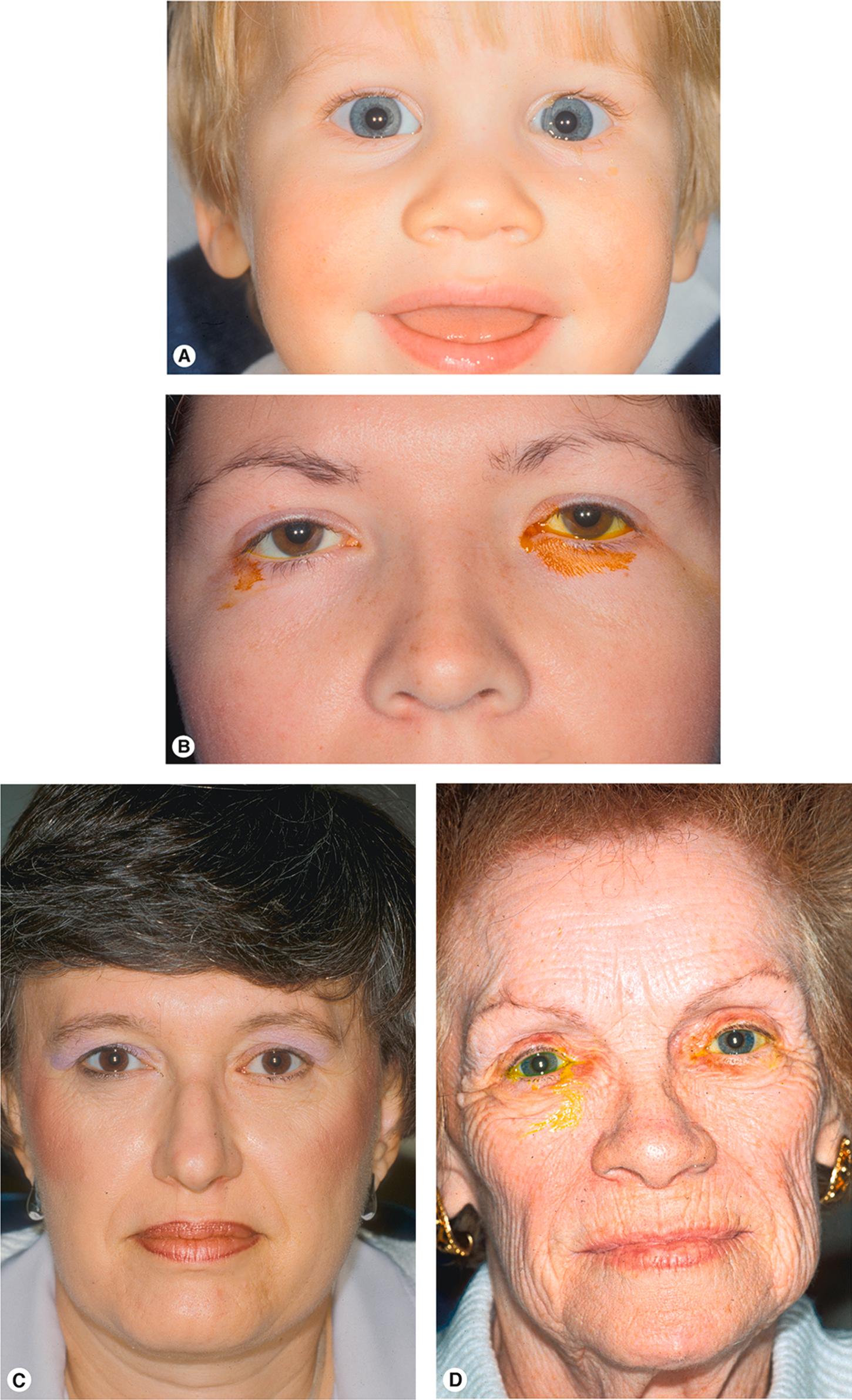
A child who is seen with a tearing eye, often associated with mattering, has a congenital NLD obstruction until proven otherwise. This obstruction presents in the first month or two of life. In some children the mattering is present throughout the day and in others the mattering may be present only upon wakening. The cause of the obstruction is a congenital membrane occurring at the valve of Hasner. In more than 90% of children, this membrane ruptures spontaneously within the first year of life. Acute dacryocystitis can occur but is rare.
When a young adult is seen with epiphora, the cause is usually related to canalicular obstruction or trauma. Canalicular obstruction can occur after viral conjunctivitis. Often this obstruction is in all four canaliculi, causing complete scarring of each canaliculus. In other patients, traumatic lacerations of the eyelid may be associated with canalicular lacerations. In these patients, the obstruction is usually focal and in one canaliculus. Facial fractures may cause damage to the NLD, but obstruction is less common that you might expect. As you might expect, trauma is more common in young men than in young women.
A middle-aged adult, usually a woman, describes to you recurrent symptoms of true epiphora. In some cases, the epiphora is associated with slight pain and tenderness in the medial canthus, suggesting mild dacryocystitis. In most patients, the epiphora resolves spontaneously over days or weeks. Interestingly, some patients may sneeze a small cast of stones out the nose. Passing of the dacryolith usually results in resolution of the symptoms. In some cases, your irrigation of the NLD improves the symptoms. In some patients, symptoms are recurrent and the patient may require surgical treatment ( Figure 10.4 ).
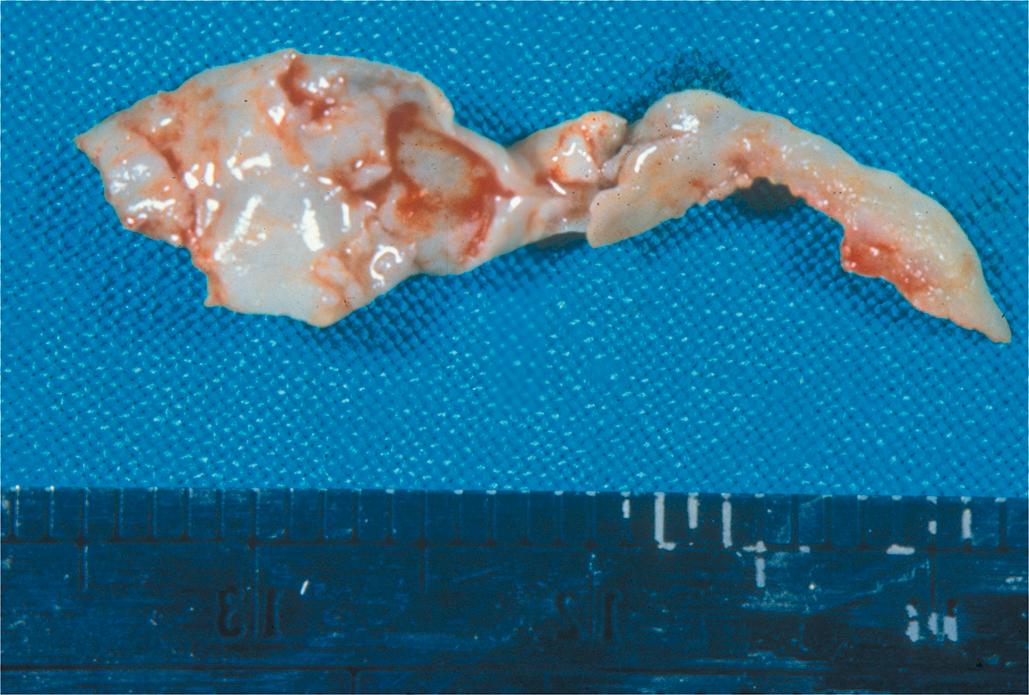
Almost as common as stones, it seems, is the woman with canalicular obstruction due to breast cancer treatment with docetaxel anhydrous. You recognize that patient from the past medical history or review of systems. Most patients with this cause of tearing equate the start of the tearing with the initiation of the chemotherapy. Fortunately, this problem has become less common as the dosage and schedule for the drug have been decreased over time. Most patients with canalicular obstruction due to this drug can be cured with lacrimal stent placement.
An older adult, again usually a woman, is seen with epiphora resulting from primary acquired NLD obstruction. The cause of this scarring in the distal portion of the NLD is not known. Symptoms include epiphora, chronic mucopurulent discharge (chronic dacryocystitis), and acute cellulitis of the lacrimal sac (acute dacryocystitis; Figure 10.5 ).

Although these diagnoses by age are generalizations, they are correct for most patients. The physical examination proves or disproves your tentative diagnosis.
What findings in the history suggest lacrimal duct obstruction?
What are the two common causes of the watery eye?
Review the causes of epiphora based on age (very important; do not skip this).
Tear drainage can be blocked at any point from the punctum to the valve of Hasner. The lacrimal drainage system can be divided into upper and lower systems. The upper system starts at the punctum and includes the canaliculi and the common internal punctum. The lower system consists of the lacrimal sac and NLD. Upper system obstruction, at the punctum or in the canaliculus, causes tearing only. Normally, mucoid secretions drain down the duct. Lower system obstruction, usually in the NLD, causes retention of mucus or pus in the lacrimal sac. NLD obstruction may present as tearing and/or mucopurulent discharge. Partial obstruction (also called functional obstruction) of the NLD commonly occurs. Patients with partial obstruction often have tearing in the cold and wind, as discussed earlier. Mucus produced in the sac is drained sufficiently to prevent signs and symptoms of dacryocystitis.
It is almost a cliché, but it is true that the examination starts when the patient walks into the room. You may notice an obvious cause of epiphora, such as ectropion, entropion, discharge, ocular inflammation, dacryocystitis, or facial nerve palsy. The patient may have a large tear lake or frank epiphora. The patient may have a tissue in hand. If so, watch to see if the patient wipes the eyes when epiphora is present or merely wipes the eyes as a habit.
The patient with tearing needs a complete eye examination with an emphasis on the eyelid, eyelash, and lacrimal system ( Box 10.3 ).
Congenital NLD obstruction
Trauma (canalicular laceration or facial trauma)
Canalicular disease (usually, postherpetic viral cause)
Dacryolith (usually, recurrent symptoms)
Canalicular obstruction in woman treated with docetaxel
Primary acquired NLD
A number of eyelid problems may cause tearing. Ectropion resulting from any cause may prevent tears from reaching the lower punctum and canaliculus. Minor amounts of ectropion may go unnoticed but may cause punctal eversion. More severe cicatricial or paralytic ectropion may prevent the lacrimal pump from functioning properly. Entropion is a cause of reflex tearing. If an older patient describes intermittent inward turning of the eyelid that is not seen on the examination, ask him or her to squeeze the eyes tightly. Forceful spasm of the orbicularis muscle may elicit entropion. Patients with cicatricial entropion have eyelashes or keratinized skin against the ocular surface. Posterior lamellar scarring may be associated with damage to the conjunctiva, causing a poor tear film.
Eyelash ptosis is a sure sign of floppy eyelid syndrome , which can be the cause of a watery eye because of either reflex irritation or lacrimal pump problems caused by the extreme laxity (see next section). These patients, most commonly heavy middle-aged men, have very loose eyelids that are easily everted ( Figure 10.6 ). Erythema of the bulbar and palpebral papillary conjunctiva is usually seen accompanying the eyelash ptosis. Remember to ask about snoring, and if it is severe, refer your patient for evaluation of obstructive sleep apnea. Patients with obstructive sleep apnea also have a higher incidence of glaucoma, possibly related to nighttime hypoxia. Eyelids with floppy eyelid syndrome have been shown to have decreased elastin as well as an altered ultrastructure, possibly because of upregulation of elastin degradation enzymes.
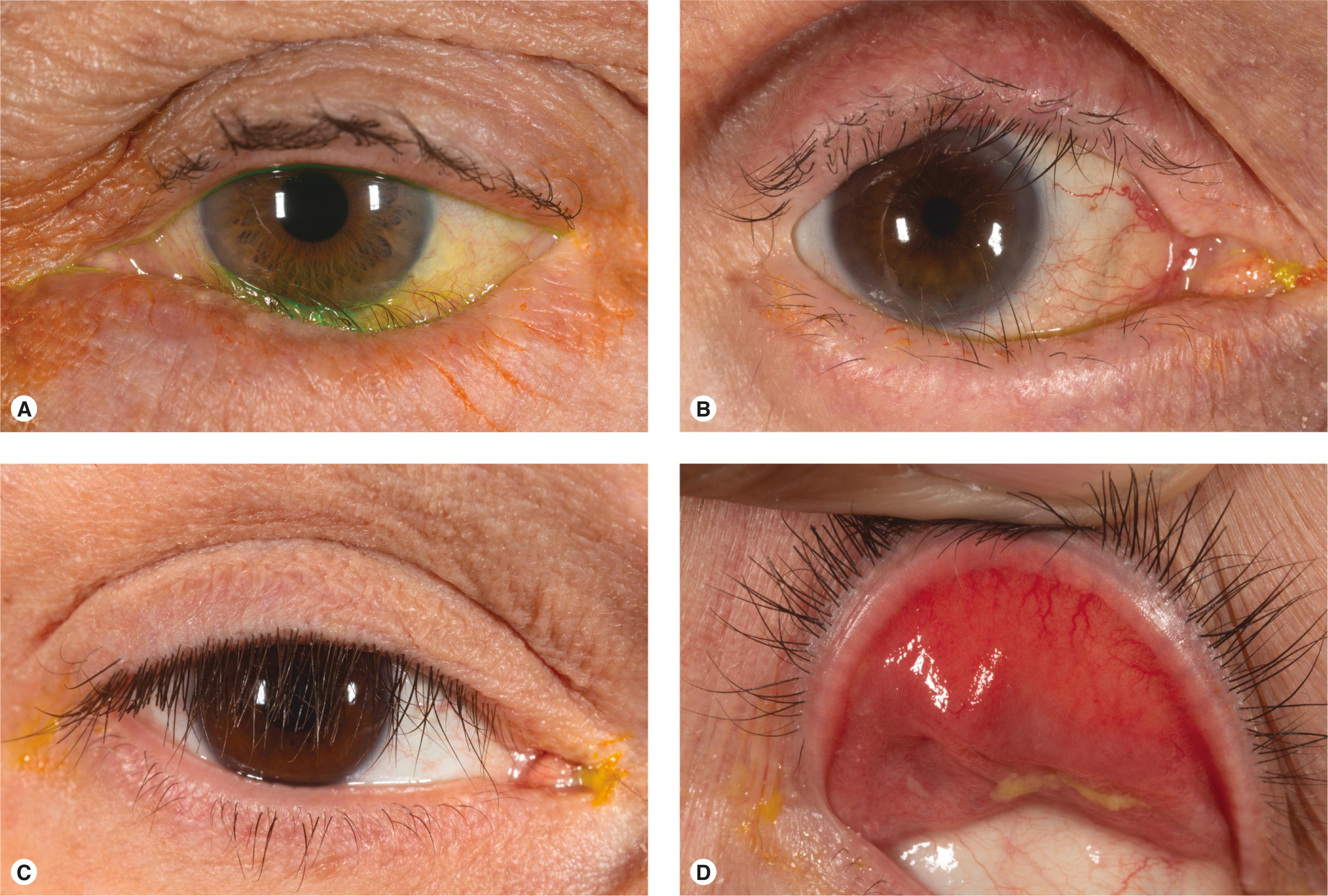
On occasion, you see a patient who is constantly rubbing one or both eyes in an attempt to pull out mucous strands. In some cases, the rubbing can be fairly aggressive. This syndrome is known as mucous fishing syndrome . Dryness is probably the original cause of the irritation, but the constant rubbing seems to aggravate the problem, making the situation worse. Other factors may play a role; the condition is poorly understood.
Lacrimal pump problems are associated with lid deformity, incomplete blink, and involutional laxity of the eyelids. Scar tissue may cause the lids to be stiff and unable to blink completely and spontaneously. Facial nerve palsy is associated with an incomplete and weak blink that prevents normal lacrimal pump function. In the absence of a strong Bell phenomenon, corneal exposure may also be present, creating an element of reflex tearing as well.
The most common lacrimal pump problem is related to the laxity of the eyelids associated with aging. These involutional changes do not allow tight apposition of the eyelid against the eye. Lid laxity can be diagnosed by the lid distraction test and the snap test. In the lid distraction test, the normal lower eyelid cannot be pulled more than 6 mm off the eyeball. If more than 6 mm of distraction is present, the lid is said to be lax. The snap test is performed by pulling the lid downward off the eyeball. A lid with normal tone and no laxity should snap into position spontaneously. Greater amounts of laxity are associated with increasing numbers of blinks required to return the lid to normal position. I usually record the results of the snap test like this: Eyelid returns to normal position with one blink or two blinks (see Chapter 3 ).
Eversion of the lower punctum may be subtle and associated with tearing, especially in a young patient ( Figure 10.7 ). The normal punctum is not visible on slit lamp examination until the eyelid is manually inverted. A vertical punctum is abnormal (the punctum is visible without physically everting the eyelid). Stenosis of the punctum often follows eyelid eversion because of drying and shrinkage of the mucosa of the punctum. Spontaneous stenosis or closure of the punctum was commonly associated with echothiophate iodide drops for glaucoma treatment, but this medication is rarely used now. Punctal stenosis can, uncommonly, be associated with most antiglaucoma medications, however. A more common punctal problem related to these medications is a dermatitis of the eyelid skin causing eyelid eversion. A change in glaucoma drops often corrects this problem. Do not forget that almost any glaucoma drop can become irritating over time and exacerbate any subtle lubrication, pump, or drainage problem. Congenital punctal atresia is uncommon but may be present in children, often seen as a family trait (see Figure 10.17 ). In rare patients, the canalicular system may be normal but the puncta may be covered with a thin membrane. A discharge from a dilated punctum (pouting punctum) should alert you to a diagnosis of canaliculitis, an uncommon but frequently overlooked cause of a mattering eye. An even less common congenital problem is an accessory punctum (discussed later).
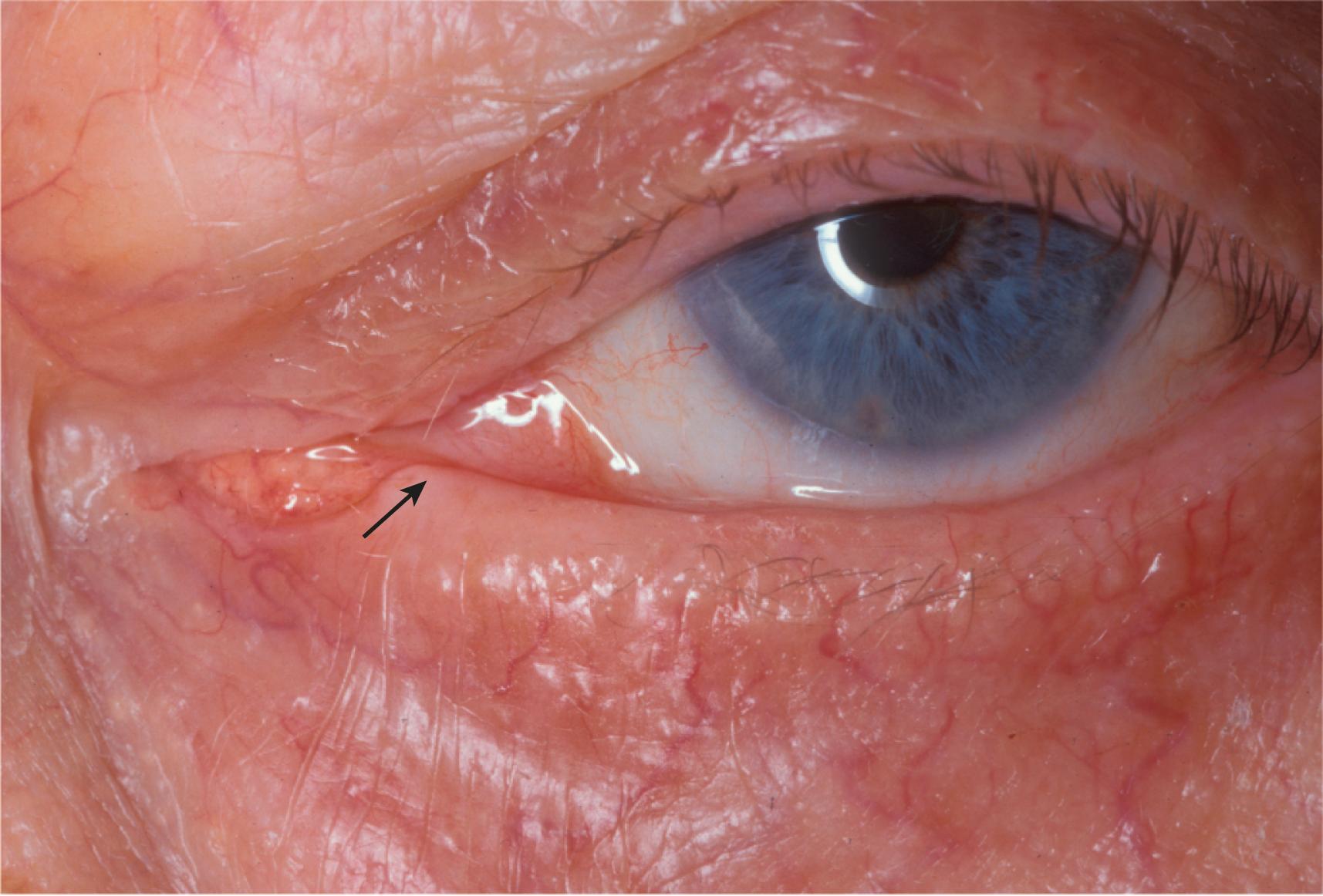
Any condition that results in eyelashes rubbing against the eye may cause corneal or conjunctival irritation, resulting in reflex tearing. Marginal entropion is a common cause of trichiasis (see Chapter 5 ). Secondary eyelid margin changes resulting from posterior lamellar shortening may be caused by chronic blepharitis. In these patients, reflex tearing is the result of abnormal lashes rubbing the eye and a poor tear film.
At this point in the examination, you have eliminated eyelid or eyelash problems as a cause of tearing. What are some eyelid and eyelash problems that can cause tearing? Make a checklist for your examination.
You have established that the patient has true epiphora and have made a tentative diagnosis based upon the patient’s age.
The lacrimal examination confirms your tentative diagnosis.
Although the lacrimal system examination may seem daunting at first, it is really quite easy and quick when you get familiar with it. One shortcut is to look for signs of dacryocystitis if you suspect an NLD obstruction; the diagnosis is made if:
Signs of acute dacryocystitis are present
You can express pus or mucoid material from the lacrimal sac
A mucocele is present
Any one of these three findings makes the diagnosis of NLD obstruction. No further testing is necessary. The signs of acute dacryocystitis include swelling, erythema, and tenderness in the medial canthus. Any purulent or mucoid discharge that can be manually expressed from the sac is diagnostic for NLD obstruction. A mucocele is diagnosed when a palpable cystic mass is present in the medial canthus ( Figure 10.8 ). A mucocele results when obstruction at both the NLD below and the common internal punctum above causes the lacrimal sac to fill with mucus.
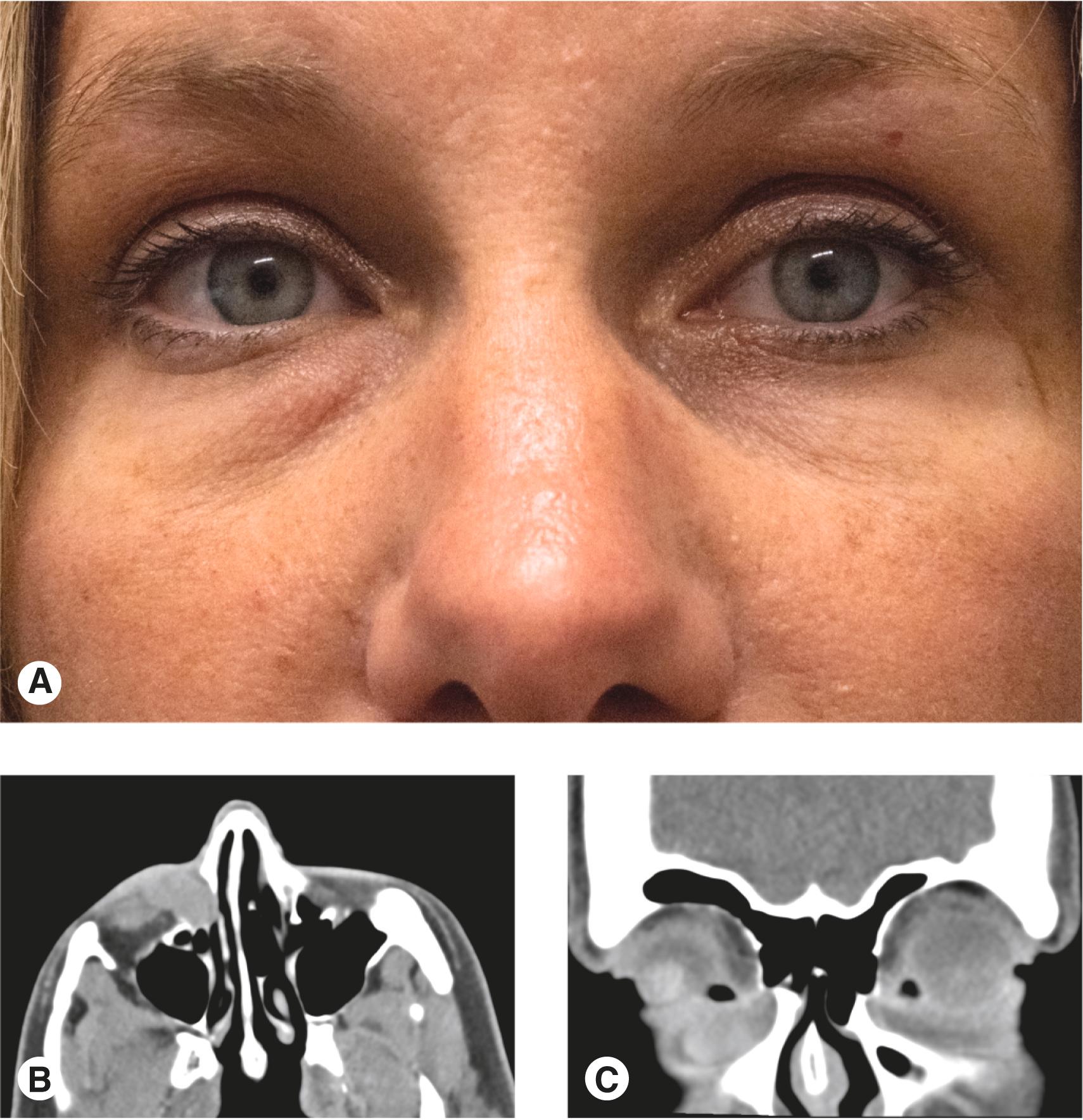
After you have checked the obvious signs of NLD obstruction, move the slit lamp into position and evaluate the tear lake. If lacrimal obstruction is present, the tear lake is high. Obstruction of the NLD may cause reflux of debris seen floating in the tear lake. A block at the puncta or canaliculi results in a large tear lake without any debris present. Remember to evaluate the lacrimal lake before placing any drops in the eye. Next take a look at the cornea to rule out any obvious corneal pathologic changes. Watch the patient blink spontaneously and see how much of the cornea is covered with a blink. Look at the lid margins for signs of blepharitis or marginal entropion. Evaluate the position of the punctum. Remember that the normal punctum is not easily visible without slight manual eversion of the eyelid.
Next check the lacrimal system vital signs ( Box 10.4 ):
Dye disappearance test
Palpation of the canaliculus
Lacrimal irrigation
Dye disappearance test
Palpation of canaliculi
Irrigation of lacrimal system
The dye disappearance test ( Figure 10.9 ) is one of the most important lacrimal tests that you do. After instilling a drop of a topical anesthetic, place a well-formed drop of 2% fluorescein into each conjunctival fornix. A fluorescein drop or strip works, but poor drainage is less obvious. After 5 minutes, check to see how much dye is retained in each eye. The dye disappearance test is very good for confirming lacrimal obstruction. The yellow dye spontaneously clears from a normal eye. A normal result is recorded as spontaneous symmetric dye disappearance. An abnormal result is recorded as dye retained in the right or left eye. This test is most valuable when symptoms of epiphora are asymmetric. This is a very good test to use in both children and adults. In most patients, the results of the tests are obvious. However, in some older adults, the conjunctiva stains with fluorescein in both eyes. Nevertheless, you may be able to evaluate the size of the tear film as an indicator of spontaneous tear drainage.
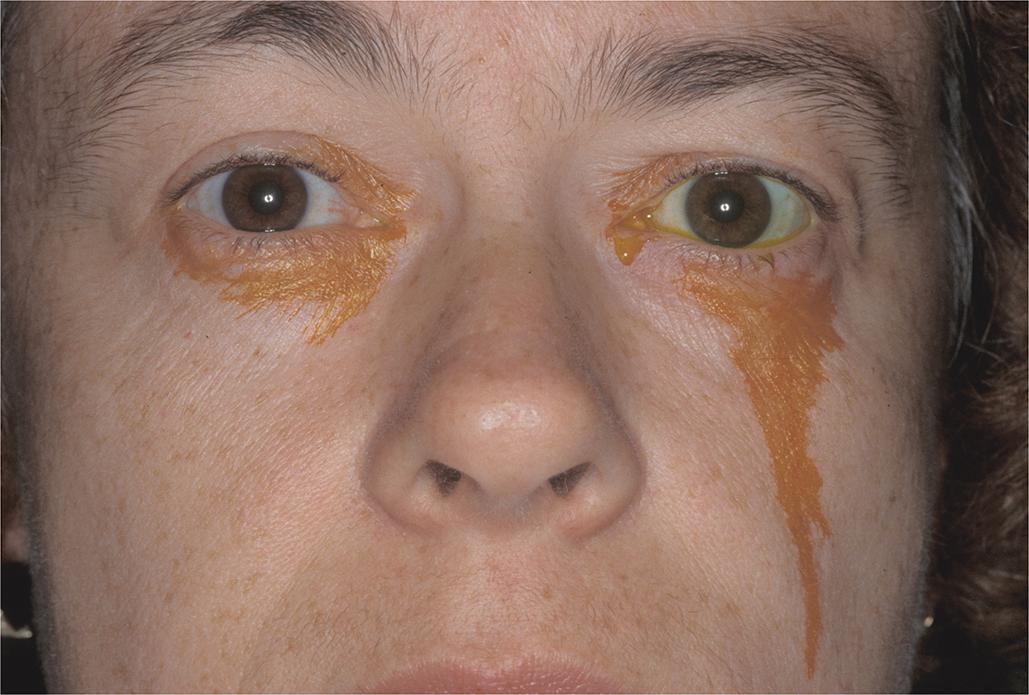
Next, demonstrate the patency of the upper and lower canaliculi using a lacrimal probe. This diagnostic test should not be confused with therapeutic NLD probing. To emphasize this distinction, we call this diagnostic procedure canalicular palpation ( Figure 10.10A ). After gentle punctal dilation, a 0 Bowman probe is carefully placed in the canaliculus ( Figure 10.11 ). The lid should be pulled laterally and the probe directed toward the sac. If you meet resistance or the lid moves with the probe, you are probably pushing against the wall of the canaliculus and may cause a false passageway. The probe should pass easily to the lacrimal sac, where a hard stop should be present. This hard stop represents normal passage of the probe into the sac against the lacrimal bone. A soft stop is said to be present if a soft tissue obstruction at the lacrimal sac is encountered ( Figure 10.12 ).

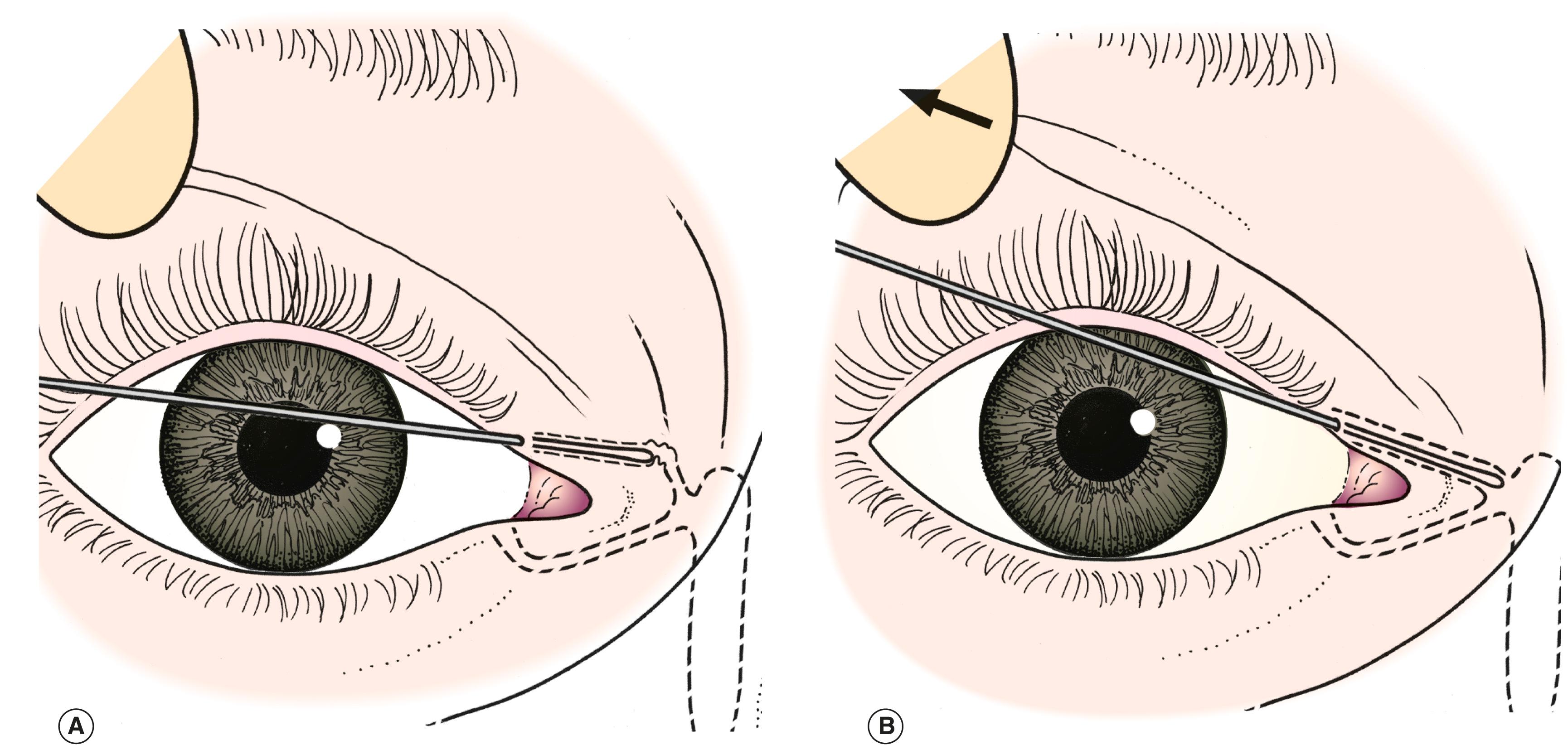
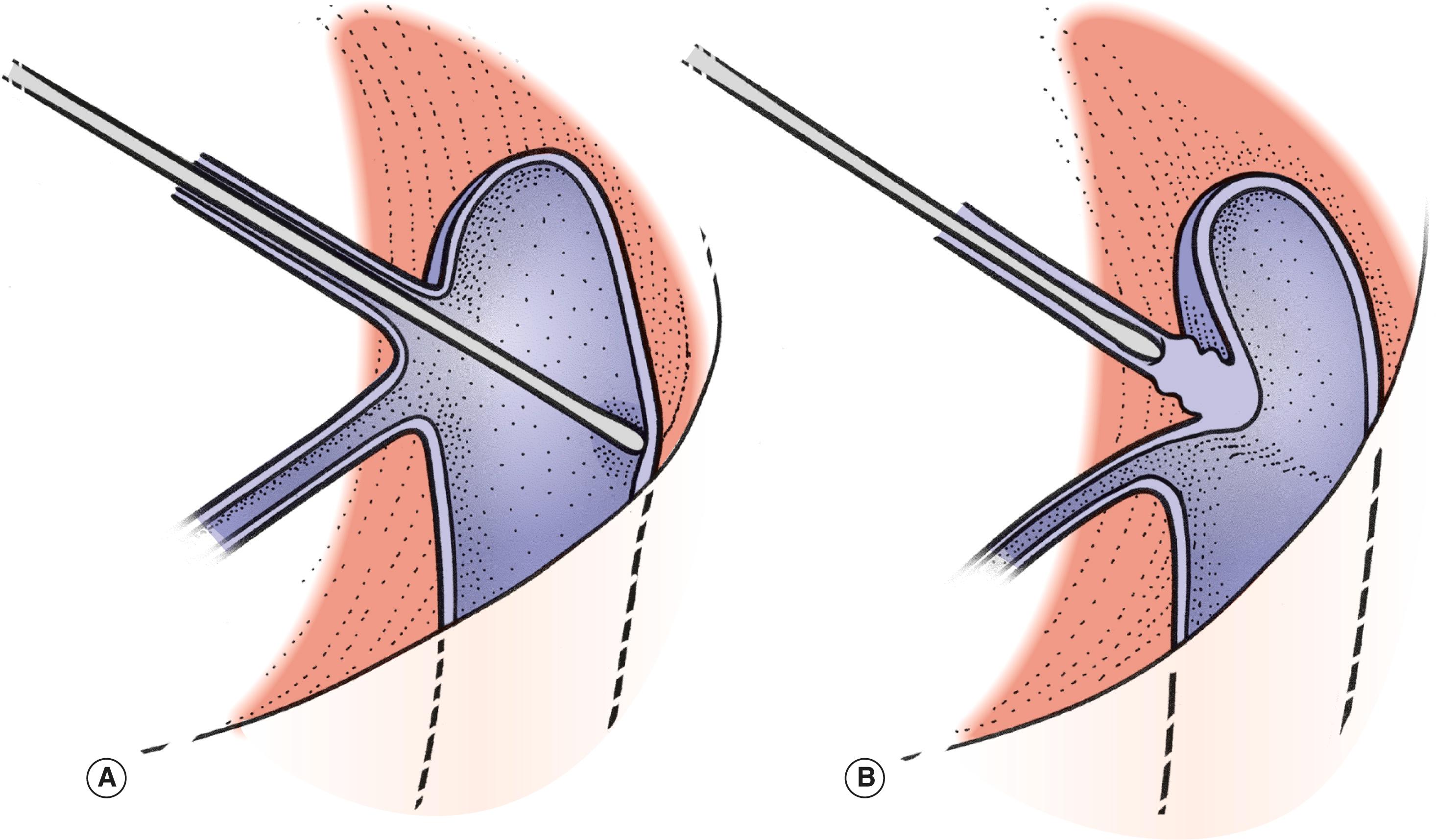
Careful passage of a 0 Bowman probe should not cause pain. A mild to moderate amount of tenderness may be encountered as the probe passes through the common internal punctum. Under no circumstances should you probe into the NLD as a diagnostic procedure.
Lacrimal irrigation (see Figure 10.10B ) tells you if the NLD is normal, partially obstructed, or closed. Using a lacrimal irrigation cannula in the lower canaliculus (not the sac), you should be able to irrigate saline or water easily into the nose without any reflux around the cannula or out the upper canaliculus (normal NLD). If you cannot irrigate at all, make sure the cannula is properly placed and is not against the wall of the canaliculus. Any reflux from the lower or upper canaliculus is abnormal, suggesting resistance to flow down the duct. If the patient does not taste the fluid in the throat, occlude the upper punctum with a cotton-tipped applicator (an assistant can help with this) and irrigate again. If you can irrigate into the nose with pressure on the syringe, the patient has a partially obstructed or narrow duct (functional obstruction). If you cannot irrigate with pressure on the syringe, the duct is closed (anatomic obstruction). After you are comfortable with the irrigation process, try this: When your patient has a functional obstruction, try to irrigate with progressively more pressure until you get a bit of reflux. This gives you an idea of how much fluid the NLD can drain; it is a form of tear drainage stress test.
You may notice that I am not recommending the historically used Jones test for epiphora (which you may have read about elsewhere); it is time consuming and not necessary for making any decision regarding therapy.
Become a Clinical Tree membership for Full access and enjoy Unlimited articles
If you are a member. Log in here